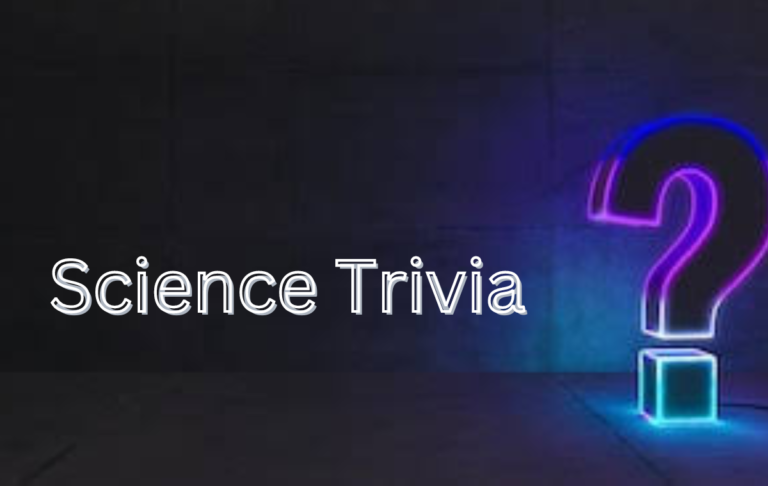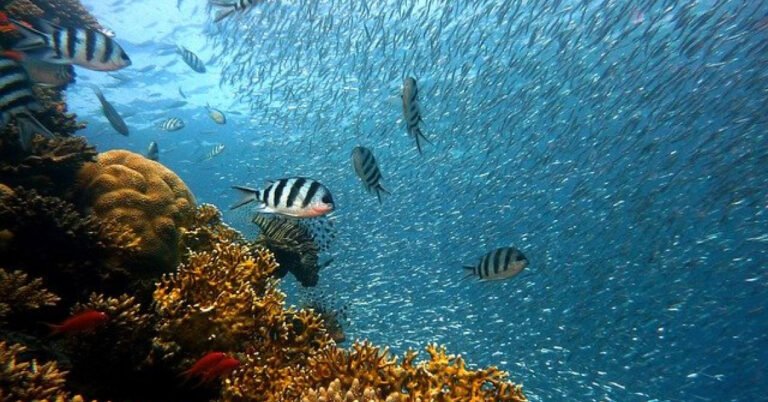From the mysteries of the universe to the intricacies of the human body, science is a field filled with fascinating facts and mind-bending concepts.
In this article, we will explore 250+ science trivia questions, ranging from the easiest to the most challenging.
These questions will test your knowledge of biology, chemistry, physics, astronomy, and more.
What is Science Trivia?
Science trivia refers to a collection of questions and answers related to various scientific fields such as biology, chemistry, physics, and earth science.
These questions are designed to test one’s knowledge and understanding of scientific concepts and facts.
Science trivia can be used as a fun activity in classrooms or as a way to challenge oneself or others.
How to Learn Science Trivia
Learning science trivia can be a fun and engaging way to expand your knowledge. There are many resources available online that offer science trivia questions and answers.
These websites offer a wide range of science trivia questions that cover various topics such as general science, biology, chemistry, Earth science, physics, and STEM.
These quizzes can be a great way to test your knowledge and learn something new.
250+ Best Science Trivia Questions and Answers (Easiest to Hardest)
Here are 250+ best science trivia questions and answers from the easiest to the hardest:
Easiest Best Science Trivia Questions and Answers
1. Animals that suckle their young one are called
- Answer: Mammals
2. What part of the plant conducts photosynthesis?
- Answer: Leaf
3. What is the boiling point of water?
- Answer: 100°C
4. Which is the largest land animal?
- Answer: Elephant
5. What helps pump blood through the entire body?
- Answer: Heart
6. What are the three states of matter?
- Answer: Solid, Liquid, and Gas
7. Frog is a reptile or amphibian?
- Answer: Amphibian
8. If one boils water it will convert into what?
- Answer: Steam
9. Which group of animals have scales?
- Answer: Reptiles
10. Where does our food collect after we chew and swallow it?
- Answer: Stomach
11. Which material has the highest transparency?
- Answer: Glass
12. Which animal is best adapted to the desert?
- Answer: Camel
13. What part of the skeletal system protects the brain?
- Answer: Skull
14. Which pigment gives the leaves its green color?
- Answer: Chlorophyll
15. What tissue connects muscles to bones?
- Answer: Tendon
16. Which nutrient plays an essential role in muscle-building?
- Answer: Protein
17. Which scientist proposed the three laws of motion?
- Answer: Isaac Newton
18. What energy emerges from motion?
- Answer: Kinetic energy
19. The standard unit of measurement for energy is what?
- Answer: Joules
20. Which biologist proposed the theory of evolution through natural selection?
- Answer: Charles Darwin
21. The outward force, away from the center, felt by an object in circular motion is called what?
- Answer: Centrifugal force
22. “For every action, there is an equal and opposite reaction.” Is what Newton’s law of motion?
- Answer: Third Law
23. Which cell organelle is also called the powerhouse of the cell?
- Answer: Mitochondria
24. The bending of light through a glass prism is called?
- Answer: Refraction
25. — is not a form of carbon
- Answer: Ferrite
26. An acidic liquid will have what pH?
- Answer: Low pH
27. Which is the lightest element in the periodic table?
- Answer: Hydrogen
28. Earthquakes are caused due to movements of what?
- Answer: Tectonic plates
29. What elements are the most common in the human body?
- Answer: Oxygen, Carbon, Hydrogen
30. This essential gas is important so that we can breathe.
- Answer: Oxygen
31. What is the nearest planet to the sun?
- Answer: Mercury
32. The earth has three layers of varying temperatures. What are its three layers?
- Answer: Crust, Mantle, and Core
33. What do bees collect and use to create honey?
- Answer: Nectar
34. What is the rarest blood type?
- Answer: AB negative
35. On what part of your body would you find the pinna?
- Answer: Ear
36. The plant Earth is surrounded by different layers of gas, which when taken together, we call the what?
- Answer: Atmosphere
37. Diabetes develops as the result of a problem with which specific organ in the body?
- Answer: Pancreas
38. True or false: sound travels faster in air than in water
- Answer: False
39. How long does a human red blood cell survive?
- Answer: 120 days
40. True or false – lightning is hotter than the sun
- Answer: True
41. This planet spins the fastest, completing one whole rotation in just 10 hours. Which planet is it?
- Answer: Jupiter
42. True or false: sound travels faster in the air than in water.
- Answer: False
43. At what temperature are Celsius and Fahrenheit equal?
- Answer: -40.
44. How many teeth does an adult human have?
- Answer: 32
45. Who was the first woman in space?
- Answer: Valentina Tereshkova
46. What is the scientific word for push or pull?
- Answer: Force
47. Where on the human body are the most sweat glands?
- Answer: Bottom of the feet
48. How many bones are in the human body?
- Answer: 206 bones
49. Can lightning strike the same place twice?
- Answer: Yes
50. Which form of energy can we see with the naked eye?
- Answer: Light
51. The Earth rotates on its axis once every _ hours.
- Answer: 24
52. The chemical formula for carbon dioxide is _.
- Answer: CO2
53. The force that opposes motion is called what?
- Answer: Friction
54. A chemical reaction in which heat is released is called an _ reaction.
- Answer: Exothermic
55. A mixture of two or more substances that does not form a new substance is called a _.
- Answer: Solution
56. What is the process of breaking down food called?
- Answer: Digestion
57. How many elements are there in the periodic table?
- Answer: 118
58. Which planet has a collective 53 moons, making it the planet in our solar system with the most number of moons?
- Answer: Saturn
59. Where can you find the smallest bone in the human body?
- Answer: Middle Ear
60. Can you hear anything in outer space?
- Answer: No, there is no medium for sound to travel through
61. From what tree do acorns come from?
- Answer: Oak trees
62. What is the tallest type of grass?
- Answer: Bamboo
63. What type of animal was Laika?
- Answer: Dog
64. What is the hardest known natural material?
- Answer: Diamond
65. True or False? Chameleons change colours only to blend into their environment.
- Answer: False
66. What is the name of the biggest part of the human brain?
- Answer: The cerebrum
67. How much part of the earth is covered with water?
- Answer: 71%
68. How many colours are there in a rainbow?
- Answer: Seven
69. What is the long winter sleep of animals called?
- Answer: Hibernation
70. Which is the nearest star to the Earth?
- Answer: Sun
71. How many moons does the Earth have?
- Answer: Only one
72. Small rocky objects that orbit the sun are called?
- Answer: Asteroids
73. What causes day and night?
- Answer: Rotation of Earth around its axis.
74. Which season precedes Winter season?
- Answer: Autumn
75. Twins that do not look alike are called?
- Answer: Fraternal twins
76. What is everything made of?
- Answer: Matter
77. Which instrument is used to measure fever?
- Answer: Thermometer
78. What causes seasons on Earth?
- Answer: Tilt of the Earth
79. What is the vehicle used to travel to space called?
- Answer: Spacecraft
80. Man-made objects that revolve around a planet are called?
- Answer: Artificial satellites
81. How many planets are there in the Solar system?
- Answer: Eight
82. Animals that eat only meat are called?
- Answer: Carnivorous
83. How many milk teeth are there?
- Answer: 20
84. The fin located on the back of the fish is called?
- Answer: Dorsal Fin
85. Which is the strongest bone in the human body?
- Answer: Femur
86. Which type of matter has no definite shape but definite volume?
- Answer: Liquids
Related- 250+ Best Schitt’s Creek Trivia Questions and Answers (Easiest to Hardest)
Intermediate Best Science Trivia Questions and Answers
1. Scientists believe that the continents of the earth were all one large landmass 280 million years ago. The moving of tectonic plates caused this mass to break off into different pieces, making up the continents as we know them today. What was this landmass called?
- Answer: Pangea
2. What theory aims to explain how Pangea became separate continents, suggesting that the movement of tectonic plates caused the mass to break off and drift into different places?
- Answer: The Continental Drift Theory
3. How many hearts does an octopus have?
- Answer: 3 hearts
4. True or false: male seahorses give birth to their young, not the females.
- Answer: True
5. Olympus Mons is a large volcanic mountain on which planet?
- Answer: Mars
6. A person who studies fossils and prehistoric life, such as dinosaurs, is known as what?
- Answer: Paleontologist
7. The speed of light in a vacuum is approximately _ kilometers per second.
- Answer: 299,792,458
8. The measure of a substance’s ability to resist change in pH is called what?
- Answer: Buffer capacity
9. What? is the coldest temperature ever recorded on Earth.
- Answer: −128.6 °F or −89.2 °C
10. This man is responsible for reshaping the way early man believed the solar system worked. He proposed that the Earth was not the center of the universe, and that the sun was instead at the center of our solar system. Who was he?
- Answer: Copernicus
11. Dolly was the first ever living creature to be cloned. What type of animal was she?
- Answer: Sheep
12. This animal was the first ever to be launched into space. She was strapped into the Soviet Sputnik 2 spacecraft which was sent out into outer space on November 3, 1957. What was her name?
- Answer: Laika
13. An egg’s shell is what percentage of its total weight?
- Answer: 12%
14. How many bones do sharks have in total?
- Answer: Zero
15. Discovered by Alexander Fleming, this is now used to treat infections and is considered one of the most important discoveries in the field of medical science. What is it?
- Answer: Penicillin
16. What colour catches the eye first?
- Answer: Yellow
17. What is the only bone in the human body that isn’t attached to another bone?
- Answer: Hyoid bone
18. What are the four primary precious metals?
- Answer: Gold, silver, platinum, and palladium
19. What part of the human body is the axilla?
- Answer: The armpit
20. Which freezes faster, hot water or cold water?
- Answer: Hot water freezes faster than cold, known as the Mpemba effect.
21. This measurement – approximately six feet – is used to measure the depth of water. What is it?
- Answer: Fathom
22. What is a geiger counter used to measure?
- Answer: Radiation
23. True or false: your hair and your nails are made from the same material.
- Answer: True
24. An unlit match has what form of energy?
- Answer: Chemical Energy
25. This type of bond involves the sharing of electron pairs between different atoms. What do you call this bond?
- Answer: Covalent bond
26. What is the scientific term for peeling skin?
- Answer: Desquamation
27. Animals that are active during dawn and dusk are called what type of animals?
- Answer: Crepuscular
28. What percentage of the total number of known animals are invertebrates?
- Answer: 95%
29. True or false: chloroplasts can be found in animal cells.
- Answer: False
30. True or false: rainforests are considered temperate climate regions.
- Answer: True
31. This type of material does not allow electricity to flow through them easily, unlike conductors which are used for their ability to rapidly allow electricity to pass through. What is this material called?
- Answer: Insulators
32. Optics is the study of what?
- Answer: Light
33. True or false: the graduated cylinder is a tool that’s used to measure fluid volume.
- Answer: True
34. Using feet, how long does the human small intestine measure on average?
- Answer: 17 feet
35. Most of a penny is made from what type of metal?
- Answer: Zinc
36. This jungle animal, when in groups, is referred to as an ambush. What kind of animal is this?
- Answer: Tigers
37. This lunar phase happens when less than a full moon but more than a half moon is illuminated.
- Answer: Gibbous phase
38. The name of this disease stems from the medieval term that means ‘bad air’. What disease is it?
- Answer: Malaria
39. Why do bubbles pop shortly after they are blown?
- Answer: Dirt from the air
40. This is the only type of canine that can climb trees. What is it called?
- Answer: Gray Fox
41. This Greek physician was the first to keep records of his patients’ histories.
- Answer: Hippocrates
42. What two substances are the main components of bronze?
- Answer: Copper and tin
43. What does DNA stand for?
- Answer: Deoxyribonucleic Acid
44. Which Apollo moon mission was the first to carry a lunar rover?
- Answer: Apollo 15 mission
45. What was the name of the first man-made satellite launched by the Soviet Union in 1957?
- Answer: Sputnik 1
46. When a substance goes from one state of matter to another, what is that process called?
- Answer: A change of state
47. This type of cell division results in two four daughter cells, each one with half the number of chromosomes in the parent cells. What is it called?
- Answer: Meiosis
48. What is the quality of an object that allows it to float on water?
- Answer: Buoyancy
49. What are the only two egg-laying mammals in existence in the world today?
- Answer: Echidna and Platypus
50. What is it called when a solid matter transitions to a gas immediately without having to pass through the liquid state?
- Answer: Sublimation
51. What is the relationship between muscles in which one muscle assists the movement of another?
- Answer: Synergistic
52. What type of muscle relationship refers to two muscles that never move in the same direction?. When one is flexed, the other will always be extended.
- Answer: Antagonistic
53. What word describes a fluid’s ability to resist flowing?
- Answer: Viscosity
54. How does fat leave your body when you lose weight?
- Answer: Through your sweat, urine, and breath.
55. What color has the longest wavelength in the visible spectrum?
- Answer: Red
56. Who has more hair follicles, blondes, or brunettes?
- Answer: Blondes
57. At what temperature does Mercury freeze?
- Answer: -38.83 degree Celsius
58. What is the chemical name of table salt?
- Answer: Sodium Chloride – NaCl
59. At which temperature Celsius and Kelvin are equal?
- Answer: -273.1 degree celsius
60. Which two elements are liquid at room temperature?
- Answer: Mercury and Bromine
61. Which gas smells like rotten eggs?
- Answer: Hydrogen Sulphide -H2S
62. What is chlorine named after?
- Answer: ‘Chloros’ – a Greek word meaning greenish yellow.
63. The property of metal by which it can be drawn into wires is called?
- Answer: Ductility
64. The property of metal by which it can be beaten into sheets is called?
- Answer: Malleability
65. Which gas is called dry ice?
- Answer: Frozen Carbon Dioxide
66. Which is the most corrosive acid?
- Answer: Fluoroantimonic acid, HSbF6
67. What scale is used to measure the hardness of minerals?
- Answer: Mohs scale
68. Which is the smallest subatomic particle?
- Answer: Quarks
69. What is the study of materials at very low temperatures?
- Answer: Cryogenics
70. What is the most abundant state of matter on earth?
- Answer: Plasma
71. Who discovered buoyancy?
- Answer: Archimedes
72. Who formulated the Theory of Relativity?
- Answer: Albert Einstein
73. What is the Third Law of Motion?
- Answer: Every action has an equal and opposite reaction
74. What is the study of the motion of air called?
- Answer: Aerodynamics
75. Which branch of physics deals with subatomic matter?
- Answer: Quantum physics
76. Which branch of physics deals with space?
- Answer: Astrophysics
77. Which branch of physics deals with heat and thermal energy?
- Answer: Thermodynamics
78. What is the speed of sound in air?
- Answer: 343m/s
79. In which medium sound travels fastest?
- Answer: Solids
80. The property of matter that resists changes in motion is called?
- Answer: Inertia
81. What is the value of acceleration of gravity?
- Answer: 9.8m/s2
82. What type of energy is stored by a capacitor?
- Answer: Electrostatic Potential Energy
83. Which are the four fundamental forces in the Universe?
- Answer: Gravitational force, Electromagnetic force, Weak nuclear force and Strong nuclear force
84. The phenomenon due to which metals expand on heating is called?
- Answer: Thermal Expansion
85. What is the name of the first computer?
- Answer: ENIAC – Electronic Numerical Integrator And Computer
86. Where does the computer store its data permanently?
- Answer: Hard Drive
Related- 250+ Best Grey’s Anatomy Trivia Questions and Answers (Easiest to Hardest)
Hardest Best Science Trivia Questions and Answers
1. What part of the brain deals with hearing and language?
- Answer: Temporal lobe
2. This is the phenomenon that explains why people will tend to refuse to offer help when there are other people present during an emergency.
- Answer: The Bystander Effect
3. When you open a bottle of wine and leave it exposed to the air, the ethanol in it reacts with oxygen. This reaction forms what?
- Answer: Ethanoic acid
4. True or false: the Large Magellanic Cloud is farther from the Earth than Andromeda.
- Answer: False
5. ATP is the molecular unit of energy that gives our body fuel on a cellular level. What does ATP stand for?
- Answer: Adenosine triphosphate
6. What is the bone disease that literally translates to ‘porous bones’?
- Answer: Osteoporosis
7. This Saturn moon has a methane cycle, differentiating it from the other moons of the planet. What is its name?
- Answer: Titan
8. This animal’s fingerprints closely resemble that of a human’s. So much so in fact, that inspecting its fingerprint side by side with a human print might make it impossible to differentiate. What animal is it?
- Answer: Koala
9. A spider monkey’s tail can carry its weight and hold on to branches. This type of tail – which can hold on to objects and support the weight of the animal to which it belongs – is called what type of tail?
- Answer: Prehensile tail
10. The joints of the body are designed so that they allow bones to interface and move. This specific type of joint however, is rigid and does not allow movement. What type of joint is this?
- Answer: Suture joints
11. Bright’s Disease affects what part of the body?
- Answer: Kidney
12. Had pirates known about this vitamin, then they wouldn’t have suffered from scurvy. What vitamin is this
- Answer: Vitamin C
13. What medical term is used to refer to items ‘based on experience’?
- Answer: Empiric
14. What refers to the amount of blood cells in a certain amount of blood?
- Answer: Hematocrit
15. What is the unit of measure used to quantify radioactive element activity?
- Answer: Becquerel
16. Lagomorph, refers to what type of animal?
- Answer: Rabbits
17. Many of us believe that the average human has 5 senses, but that’s not actually true. What two other senses do we have that are often left unknown to most lay people?
- Answer: Vestibular and proprioceptive senses
18. What does the vestibular sense do?
- Answer: Informs the brain of a person’s position in space
19. What does the proprioceptive sense do?
- Answer: Informs the brain of the relative position of certain body parts to others
20. The astronomical unit (au) is a unit of measurement based on the average distance between what two bodies?
- Answer: The Earth and Sun
21. Humans and chimpanzees share roughly how much dna?
- Answer: 0.98
22. What is the heaviest organ in the human body?
- Answer: Liver
23. What is known as the “master gland” of the human body?
- Answer: Pituitary gland
24. How much taller is the eiffel tower during the summer?
- Answer: 15cm
25. What is the only planet that spins clockwise?
- Answer: Venus
26. The horsehead nebula can be found in what constellation?
- Answer: Orion
27. How often does Halley’s comet appear in the sky?
- Answer: Every 75-76 years
28. On what continent would you not find bees?
- Answer: Antarctica
29. In science, how long is an eon?
- Answer: 1 billion years
30. In what year did the Apollo 7 human spaceflight take place?
- Answer: 1968
31. Big bang machines are also known as?
- Answer: Large Hadron
32. How long does it take for light from the sun to reach earth?
- Answer: 8 minutes 20 seconds
33. What is the end cause of every human death?
- Answer: Cerebral hypoxia
34. What is the only rock that floats?
- Answer: Pumice
35. The oldest living tree is 4,843 years old and can be found where?
- Answer: California
36. Who first proposed the concept of contact lenses?
- Answer: Leonardo da Vinci
37. How many constellations are in the night sky?
- Answer: 88
38. What is the name of the world’s largest reef?
- Answer: Great Barrier Reef
39. What is the scientific name for the trunk of an elephant?
- Answer: Proboscis
40. What are the male honey bees called that are the only members of the colony allowed to mate with the queen?
- Answer: Drones
41. What animal is the closest living relative to the t-rex
- Answer: Chicken
42. In 1980, mount st. helens erupted in what US state, killing 57 people?
- Answer: Washington State
43. What power plant near Kiev, Ukraine, released radioactive fallout across much of Europe and rendered thousands of acres of land near the accident site uninhabitable for thousands of years?
- Answer: Chernobyl nuclear power plant
44. In 1986 an american space shuttle disintegrated after launch, killing all aboard, what was the name of the shuttle?
- Answer: Space Shuttle Challenger
45. Who invented the morse code?
- Answer: Samuel Finley Breese Morse and Alfred Vail
46. What islands were extensively studied by Charles Darwin?
- Answer: Galapagos Islands
47. Which dwarf planet was discovered by Clyde Tombaugh while working at the Lowell observatory in Flagstaff in 1930?
- Answer: Pluto
48. Which civilization is regarded as the first to have a functional theory of the planets?
- Answer: Babylonian
49. True or False? lower tension on a tennis racquet produces more control and less power.
- Answer: False
50. How many more bones do babies have than adults in the human body?
- Answer: About 100 more bones
51. What metals are instantly tarnished when exposed to air?
- Answer: Potassium
52. How much would a teaspoonful of a neutron star weigh?
- Answer: 6 billion tons
53. How much further does Hawaii move to Alaska every year?
- Answer: 7.5cm closer
54. What is chalk made out of?
- Answer: Trillions of microscopic plankton fossils.
55. How much longer will it be until it’s too hot for us to live on Earth?
- Answer: 2.3 billion years
56. True or false, stomach acid is strong enough to dissolve stainless steel.
- Answer: True
57. What is the Earth surrounded by after its core?
- Answer: Liquid Iron
58. What planet is made of diamonds?
- Answer: 55 Cancri e
59. What is the rarest naturally occurring element on Earth?
- Answer: Astatine
60. Which appealing yellow fruit is slightly radioactive due to its high potassium content?
- Answer: Banana
61. The quadriceps is, as the name suggests, a group of four prevailing mus les including the rectus femoris. This group of muscles covers the front and sides of what leg bone?
- Answer: Femur
62. “No” is the negative-sounding chemical symbol that represents an element that was first produced in the US in 1958. The element is named after a man who more famously lent his name to a series of prizes. With a single guess, name either the man or the element.
- Answer: Nobelium (Alfred Nobel)
63. Also part of cow farts, what simple hydrocarbon, chemical formula CH4, is the primary component of natural gas?
- Answer: Methane
64. The Mobius strip was the inspiration for a universal symbol first created in 1970 and composed of 3 arrows in a roughly triangular shape. This symbol stands for what action?
- Answer: Recycling
65. Theoretically, Hawking radiation is emitted by what terrifying space things that come in stellar and supermassive varieties?
- Answer: Black Holes
66. Which is the only planet in our solar system whose rotation is almost at a right angle to its orbit (i.e., it spins on its side)? The largest moon of this planet is Titania.
- Answer: Uranus
67. Often associated with horses but also used as an anesthetic on many types of animals, what drug is often nicknamed as “Special K”?
- Answer: Ketamin
68. The “main-sequence” stage of what type of large, hot object comes from the balance of gravity and nuclear reactions?
- Stars
69. Which organ in the human body is the only one that can float in water
- Lungs
70. The most abundant sulfide mineral is pyrite. But this mineral’s lustrous appearance is more commonly known by what two-word phrase?
- Answer: Fool’s gold
71. Now displayed in Chicago’s Field Museum of Natural History, 90 percent of the fossils from what massive theropod dinosaur was unearthed in South Dakota in 1990 and was nicknamed “Sue” after it was discovered by paleontologist Susan Hendrickson?
- Answer: Tyrannosaurus Rex
72. What is the two-word phrase for the set of ideas that suggest the universe is not made up of points, but rather tiny vibrating lengths?
- Answer: String theory
73. New Zealand famously has the highest density of sheep per unit area in the world. What was the name of the sheep who was the first mammal cloned from an adult cell?
- Answer: Dolly
74. Gustatory cells are primarily found on what sensory organ of the body?
- Answer: Tongue
75. According to a popular theory, dinosaurs got wiped out by the Chicxulub crater impact in what back-half-of-the-alphabet Mexican peninsula?
- Answer: Yucatán
76. Though Thomas Edison primarily used carbon filaments, most incandescent light bulbs today are made with filaments of what element, whose atomic symbol is a W for its alternate name, “wolfram”?
- Answer: Tungsten
77. A planned NASA mission will be the first to land astronauts on the moon since the Apollo program, including the first woman. This program is named, appropriately enough, for what sister of Apollo?
- Answer: Artemis
78. Acceleration is the change in an object’s velocity with respect to time. The change of an object’s acceleration with respect to time is called what?
- Answer: Jerk
79. A gigaannum is a term that represents a very long time. One billion years in fact. About 3.5 gigaannumms ago was when what critical process used to convert light energy into chemical energy is estimated to have begun?
- Answer: Photosynthesis
80. Which of the four standard bases in DNA typically pairs with thymine?
- Answer: Adenine
81. Linux uses all the letters of what operating system family that it was designed to imitate?
- Answer: Unix
82. In DNA, the four nucleotide bases are adenine, cytosine, guanine, and thymine; in RNA, what base replaces thymine?
- Answer: Uracil
83. The direct conversion of sunlight into electricity started in 1954, via solar cells using silicon. These cells are alternatively referred to by what longer “P” name?
- Answer: Photovoltaic cells
84. The jelly-like substance obtained from red algae that is often used as a solid growth medium in Petri dishes to culture microorganisms is called what?
- Answer: Agar
85. A buckyball is a stable and spherical molecule made up of what element?
- Answer: Carbon
86. Engineer Gilbert Levin insisted that a Viking Lander discovered life on what planet in 1976?
- Answer: Mars
Frequently Asked Questions
Yes, there are many fun science trivia questions and answers available
You can find a large collection of science trivia questions on websites like Reader’s Digest, Great Wolf Lodge, and AhaSlides.
Science trivia questions can be important for testing and expanding one’s knowledge in a fun and engaging way.
Conclusion
Science trivia questions can engage and educate people about the fascinating world of science in various settings, such as work, class, or social gatherings.
By answering these questions, individuals can improve their knowledge and understanding of various scientific concepts, making them more informed and curious about the world around them.
References
- momjunction.com– 65 Science Quiz For Kids Of Grades I To X
- icebreakerideas.com– 106 Fascinating Science Trivia Questions and Answers
- ahaslides.com– +50 Fun Science Trivia Questions With Answers Would Blow Your Mind in 2024





